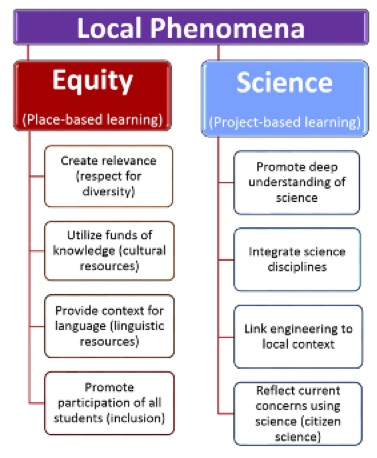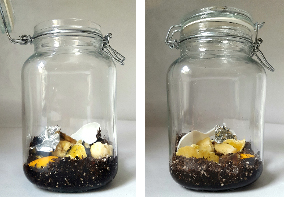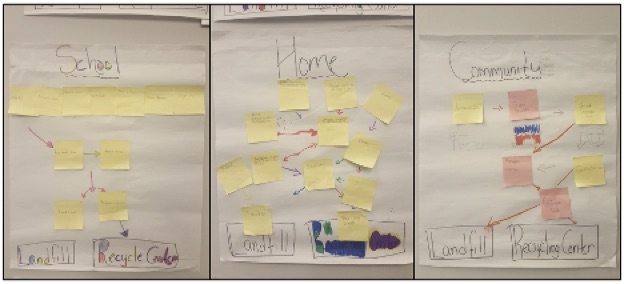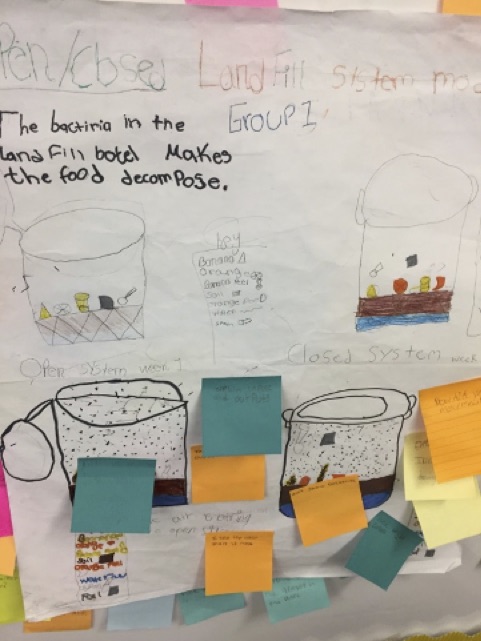phenomena
Making Everyday Phenomena Phenomenal
Using phenomena to promote equity in science instruction
The goal of the NGSS is to enable students to explain phenomena and design solutions to problems (Reiser et al. 2017). In the NGSS classroom, students make sense of phenomena and design solutions to problems as scientists and engineers do in their work (NRC 2012). This gives a purpose to science learning as students “do something” with science and become agents of their own learning.
In the past, when science instruction was guided by inquiry approaches, there was a danger of hands-on activities lacking purpose beyond being fun and engaging (referred to as “activitymania” by Moscovici and Nelson 1998). In a similar manner, a focus on phenomena raises a new danger of selecting “phenomenal phenomena” because they pique students’ interest (e.g., a visually striking yet rare natural phenomenon that students have not personally experienced). While phenomenal phenomena inspire wonder and awe (e.g., students ask, “How could that happen!?”), they may have little relevance to students’ experiences in their everyday lives. Furthermore, phenomenal phenomena may not be robust enough to sustain a science unit around a targeted set of performance expectations (PEs) over the course of instruction.
Integrating Place-Based and Project-Based Learning
In our work developing and implementing yearlong NGSS-aligned instructional materials in fifth grade for diverse student groups, we aim to make everyday phenomena phenomenal. Specifically, we use local phenomena that meet two criteria (see Figure 1). The first criterion is that local phenomena should be real and relevant to students and thus compelling to figure out. From an equity perspective, through place-based learning, students apply science and engineering to their everyday lives in their homes and communities (Endreny 2010). The second criterion is that local phenomena should be comprehensive enough to sustain a science unit that addresses multiple PEs within and across science disciplines over the course of instruction. From a science perspective, through project-based learning, students engage in collaborative investigations as they explain phenomena or design solutions to problems (Krajcik and Czerniak 2013). Below, we describe each of the equity components (left column in Figure 1) and science components (right column in Figure 1) that teachers should consider when selecting local phenomena to use in their classrooms.

Components in selecting and using local phenomena with diverse student groups.

Landfill bottles.
Over the course of nine weeks of instruction, students’ understanding of science builds coherently as they investigate what happens to their garbage in the landfill bottle systems. Students begin by investigating what happens to garbage materials (5-PS1-3 on properties of materials). When the landfill bottles start to smell in the open system, students ask, “What is that smell?” (5-PS1-1 on particle nature of matter/gas). They also ask, “What causes changes in the properties of materials in the garbage?” and “What causes smell from the garbage?” (5-PS1-4 on chemical reactions). They obtain information about microbes causing food materials to decompose and produce odor (5-LS2-1 on decomposers in the environment). In addition, they make observations of the weight of the garbage materials after some garbage materials (e.g., banana and orange) in the closed landfill bottle systems seem to have vanished (5-PS1-2 on conservation of weight/matter).
As with many science units, it is important to follow safety guidelines when students sort the garbage materials into categories and make observations of the landfill bottles (see Figure 3). Teachers should also consult school and/or district policies regarding safety in the science classroom.
Garbage sort safety guidelines
- Assemble the piles of garbage for the activity, making sure not to include broken glass or sharp objects.
- Ensure the garbage has as little liquid as possible.
- Direct students to wear protective goggles and use plastic gloves and tongs for handling the garbage.
- Direct students to wash their hands after handling the garbage.
- If students have allergies (nuts, mold, etc.), consult the school nurse before proceeding with the garbage sort. Students may view videos of decomposition.
Landfill bottle safety guidelines
- When students make observations of the landfill bottles, instruct them to look through the side of the bottles and waft smell out of the bottles. Students should not place their faces directly over the open landfill bottles.
- If a student has a known mold allergy or severe asthma, store the open landfill bottle outside the classroom. Consult with the school nurse.
- Open the closed landfill bottles outside to allow the smell to diffuse.
Direct students to wash their hands after handling the landfill bottles.
An Equity Perspective
We select a local phenomenon rooted in students’ everyday experiences in their homes and communities by capitalizing on the following equity components (see the left column in Figure 1):
Equity component 1: The phenomenon of garbage creates relevance for all students since they experience garbage every day.
Equity component 2: The phenomenon of garbage in the school, home, and community that goes to a community landfill capitalizes on students’ funds of knowledge.
Equity component 3: The phenomenon of garbage provides a context for all students to communicate their ideas using all of the meaning-making resources at their disposal, including everyday language, home language, and multimodality.
Equity component 4: The phenomenon of garbage promotes participation of all students by offering access to science and inclusion in the science classroom. As a result, abstract ideas of matter (e.g., particle nature of matter, properties of matter, chemical reaction, conservation of weight/matter) are made accessible and relevant to all students.
A Science Perspective
We select a local phenomenon that is comprehensive enough to address multiple PEs over a sustained period of instruction by capitalizing on the following science components (see the right column in Figure 1):
Science component 1: The phenomenon of garbage allows students to build their understanding of structure and properties of matter coherently over the course of a unit.
Science component 2: The phenomenon of garbage allows students to understand science more broadly across science disciplines by integrating physical science and life science.
Science component 3: The phenomenon of garbage sets the foundation for engineering in the subsequent Earth’s systems unit as students find out that plastic, which does not decompose, pollutes Earth’s systems. They design solutions to this problem by reducing the amount of plastic from water bottles in their classroom and school.
Science component 4: The phenomenon of garbage raises students’ awareness of societal concerns about garbage and plastic pollution. As a result, students use science ideas to protect the Earth’s resources and environment and to participate in citizen science.
This section offers a snapshot of two lessons from the garbage unit to illustrate how local phenomena are implemented with diverse student groups in fifth grade. The first lesson highlights place-based learning from an equity perspective, and the second lesson highlights project-based learning from a science perspective. The two lessons also highlight how teachers use grouping strategies to promote student engagement and how they use formative and summative assessments.
The local phenomenon of garbage is compelling to students because it draws on their everyday experiences in their school, home, and community. In the first lesson of the unit, each group of four or five students with varying levels of English proficiency is assigned to a pile of school lunch garbage. Students wear plastic gloves and protective goggles and use tongs to sort the garbage materials. They make observations of the garbage materials and categorize those materials based on properties (e.g., hardness, smell, reflectivity). In a whole-class discussion, students identify patterns of similarity and difference in their observations of the school lunch garbage. Then, students make observations of materials in their home garbage and categorize those materials based on properties. In small-group and whole-class discussion, students identify patterns of similarity and difference in their observations of the home garbage. This lesson addresses three-dimensional learning by blending the science and engineering practice (SEP) of planning and carrying out an investigation, the disciplinary core idea (DCI) of properties of materials, and the crosscutting concept (CCC) of patterns.
In the second lesson of the unit, students investigate garbage disposal systems in their school, home, and community. As shown in Figure 4, they use sticky notes to represent components of each system (e.g., garbage trucks) and arrows to represent interactions of the components (e.g., garbage trucks transport garbage from the dumpster to the landfill). This lesson addresses three-dimensional learning by blending SEP of developing and using models, DCI of properties of materials, and CCC of systems and system models.

Garbage disposal systems in the school, home, and community.
At the end of the lesson, students complete a science and engineering notebook entry in response to the following question: “What would happen to the garbage disposal systems if a component were missing? Give an example to support your answer.” The purpose of the exit slip is to use the familiar context of garbage in the school, home, and community for formative assessment of students’ emerging understanding of systems, which the teacher uses to guide subsequent instruction. Throughout the unit, each lesson concludes with a formative assessment, such as an exit slip, revised model, or science and engineering notebook entry.
Snapshot 2: Group Modeling of Landfill Bottle Systems

Group model of open and closed landfill bottle systems for 2–3 weeks.
At the end of the garbage unit, group models serve as artifacts for summative assessment of student understanding in relation to the targeted set of PEs. Throughout the school year, each unit concludes with summative assessment of final models to explain the anchoring phenomenon of the unit. In earlier units, students develop group final models, whereas in later units, students develop individual final models. As such, the totality of the units in our fifth-grade curriculum promote progressions of three-dimensional learning over the course of the year.
Conclusion
The Framework and the NGSS present key instructional shifts, including a shift toward explaining phenomena. Enacting these shifts, in general, and using local phenomena, in particular, are especially critical when working with students who have not experienced science and engineering as real or relevant to their lives or future careers. In this article, we offer guidance on how teachers can select and use local phenomena that compel students from diverse backgrounds to engage in three-dimensional learning and build their science understanding coherently over a sustained period of instruction. Since diverse student groups come from a wide range of backgrounds, teachers could work with their students to select local phenomena that draw on everyday experiences in students’ schools, homes, and communities. By making everyday phenomena phenomenal, we move a step closer to realizing the vision of “all standards, all students.”
Okhee Lee (olee@nyu.edu) is a professor at New York University.
Equity Instructional Materials NGSS Pedagogy Phenomena Teaching Strategies


